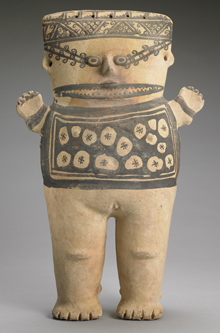
"Men and women became shamans almost equally," says Stone in a recent video tour of the exhibit, which includes 115 objects from the museum's permanent collection that portray key aspects of shamanic visionary trance.
"Shamanism is gender equal because it is a calling," explains Stone in the tour. "You can't say, 'Hey, I want to be a shaman.' It happens to you."
Criteria for becoming a shaman include having dreams that come true, or spontaneously healing someone, or any other extraordinary circumstance that singles out the person, says Stone.
"Shamanism is the world's oldest religious complex," says Stone. "It underlies institutionalized religions. It is based on having a charismatic intermediary with the divine, a person who is willing to go into a visionary state and visit the powers beyond the human or terrestrial realm."
The exhibit's title is a fragment of a larger quote from a Brazilian shaman: "For I am the Black Jaguar. It is me you must invoke if you wish to scare the illness away." The words highlight the basis of shamanism, says Stone, that the shaman is capable of changing her state of being, and "that anything is in flux between one state and another."
Sometimes people with congenital abnormalities, what we today call disabilities, were more prone to becoming a shaman, because their body was already different, according to Stone, who has conducted extensive research on shamanic trance and is the author of the 2011 book, "The Jaguar Within: Shamanic Trance in Ancient Central and South American Art."
"For I am the Black Jaguar" is on display through Saturday, Jan. 5.
